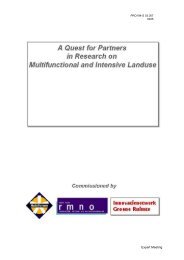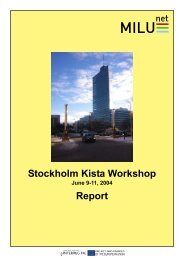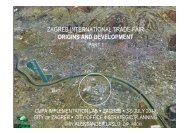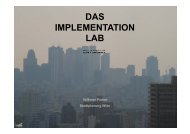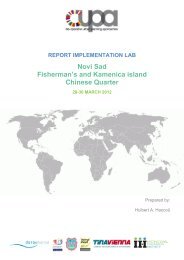2001-June 6-8 MILU - Iiinstitute.nl
2001-June 6-8 MILU - Iiinstitute.nl
2001-June 6-8 MILU - Iiinstitute.nl
You also want an ePaper? Increase the reach of your titles
YUMPU automatically turns print PDFs into web optimized ePapers that Google loves.
• Need better area planning – reinforcing existing residential neighborhoods.<br />
• Need to reinforce the existing good cultural life (more community gathering<br />
places), a few existing farms of historical significance still exist in the area.<br />
• Need to find financing for new improvements – looking for a mix of public-private<br />
sources.<br />
3. RELEVANT CASE STUDY CONSIDERATIONS<br />
The working party was asked to present a few comparable case studies with a view<br />
to illustrating possible relevancy’s and unique approaches to the problems of the<br />
Groruddalen Valley. The following considerations emerged from two case studies<br />
presented:<br />
• Redevelopment can cause dislocations on local establishments and opportunities<br />
i.e. equilibrium of land use (compatible land uses).<br />
• Need for consistency with local character.<br />
• No preference for mixed use over single use – expediency should dictate<br />
approach.<br />
• Establish a clear regional plan or strategic context for all interventions.<br />
Specific issues emerging from these presentations were:<br />
• Consider a telescoped scale of thinking – from the regional to local.<br />
• Consider the advantages of current and future infrastructure.<br />
• Consider the need for clear community definitions.<br />
• Consider the nature of edges.<br />
• Examine the degree of land coverage (large roof areas, degree of visible<br />
exposure).<br />
• Match ecology with topography.<br />
• Do not ignore political realities while considering economic and ecological<br />
considerations.<br />
4. RECURRING WORKING PARTY QUESTIONS<br />
The prevailing issues as listed were obtained through a series of observations from<br />
the working party. Although they are descriptive of the valley, these issues do not<br />
provide a sense of the larger imperatives for intervention necessary to assign<br />
development priority and planning focus. Recurring questions from the working party<br />
that would assist in this regard were:<br />
• How critical are the existing distribution functions? What are the current and<br />
future needs of this function?<br />
• Regional imperatives – has the cost of losing infrastructure been considered?<br />
• What are the known local imperatives by residents and local employers?<br />
• Is there any assessment of the valleys potential for redevelopment?<br />
19.



